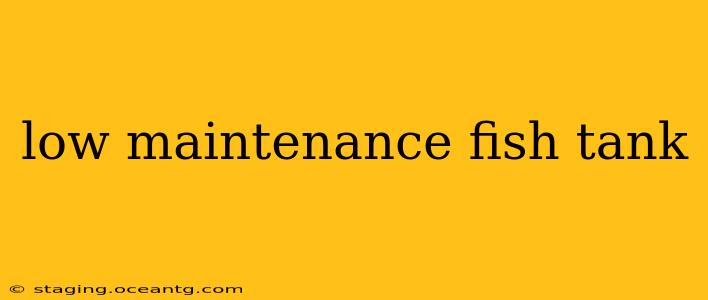Are you dreaming of an underwater world but daunted by the commitment? A low-maintenance fish tank might be the perfect solution! This guide explores everything you need to know to create a thriving aquatic ecosystem without the constant fuss. We'll delve into the best fish choices, essential equipment, and simple maintenance routines to keep your tank sparkling and your fish happy.
What Makes a Fish Tank Low-Maintenance?
The key to a low-maintenance fish tank lies in careful planning and selection. It's about choosing hardy fish that tolerate a range of conditions and a simple setup that minimizes cleaning and water changes. This doesn't mean neglecting your tank; it means optimizing it for ease of care.
What are the best fish for a low-maintenance tank?
Many hardy fish species are perfect for beginners. Some popular choices include:
- Platyfish: These vibrant, live-bearing fish are incredibly adaptable and tolerant of minor water parameter fluctuations.
- Guppies: Similar to platyfishes, guppies are colorful, prolific breeders, and easy to care for.
- Corydoras Catfish: These peaceful bottom-dwellers are excellent scavengers, helping keep your tank clean.
- Harlequin Rasboras: A schooling fish known for its peaceful nature and stunning coloration. They add a splash of movement and visual interest to your tank.
- White Cloud Mountain Minnows: These tiny, cold-water fish are incredibly hardy and can tolerate a wide range of water conditions. They are an excellent choice for beginners.
Important Note: Always research the specific needs of any fish before adding it to your tank. Ensure you provide adequate space and compatible tank mates. Overstocking your tank, regardless of how hardy the fish are, will lead to increased maintenance.
What size tank should I get for a low-maintenance setup?
While smaller tanks seem easier, a larger tank (at least 10 gallons) is actually more low-maintenance. Larger tanks are more stable, meaning water parameters fluctuate less dramatically. This stability is crucial for the health of your fish and reduces the frequency of water changes.
What equipment do I need for a low-maintenance fish tank?
You'll need a few essential items:
- Aquarium: Choose a tank size appropriate for your chosen fish.
- Filter: A good quality filter is essential for removing waste and keeping the water clean. Consider an internal filter for ease of maintenance.
- Heater (if necessary): Depending on the type of fish you choose, a heater might be required to maintain the optimal water temperature.
- Substrate: Gravel or smooth stones provide a natural look and help beneficial bacteria to colonize.
- Decorations (optional): Add plants (real or artificial) and rocks for visual appeal and fish enrichment, but avoid overcrowding the tank.
How often should I clean my low-maintenance fish tank?
A low-maintenance tank doesn't mean no maintenance. Regular, but less frequent, tasks are key:
- Water changes: Partial water changes (25-50%) should be performed every 2-4 weeks, depending on the size of the tank and the number of fish.
- Filter cleaning: Clean or replace filter cartridges according to the manufacturer's instructions, typically every 1-3 months. Avoid cleaning the filter media excessively, as it houses beneficial bacteria essential for water quality.
- Substrate cleaning: A gentle siphon can remove debris from the bottom of the tank during water changes. Avoid excessive disturbance to avoid clouding the water.
What are the signs of problems in a low-maintenance fish tank?
Even low-maintenance tanks need monitoring. Watch for these warning signs:
- Cloudy water: Indicates a buildup of waste or a problem with the filter.
- Fish exhibiting unusual behavior: Lethargy, loss of appetite, or unusual swimming patterns can signal illness.
- Unpleasant odor: A strong ammonia or rotten smell is a clear indication of a problem.
How often should I feed my fish?
Overfeeding is a common mistake. Feed your fish only what they can consume in a few minutes, once or twice a day. Avoid feeding too much, as uneaten food contributes to water quality issues.
Are there any other tips for keeping a low-maintenance fish tank?
- Research your fish: Knowing your fish's specific needs is paramount.
- Start small: Don't rush into a large, complex setup. Begin with a smaller tank and gradually expand as your confidence grows.
- Patience is key: Establishing a healthy tank takes time. Don't get discouraged if things don't seem perfect immediately.
By following these guidelines, you can enjoy the beauty and tranquility of an aquarium without the overwhelming demands of high-maintenance setups. Remember, responsible ownership involves ongoing observation and care, even with low-maintenance species. With a little planning and the right approach, your low-maintenance fish tank will thrive for years to come!
